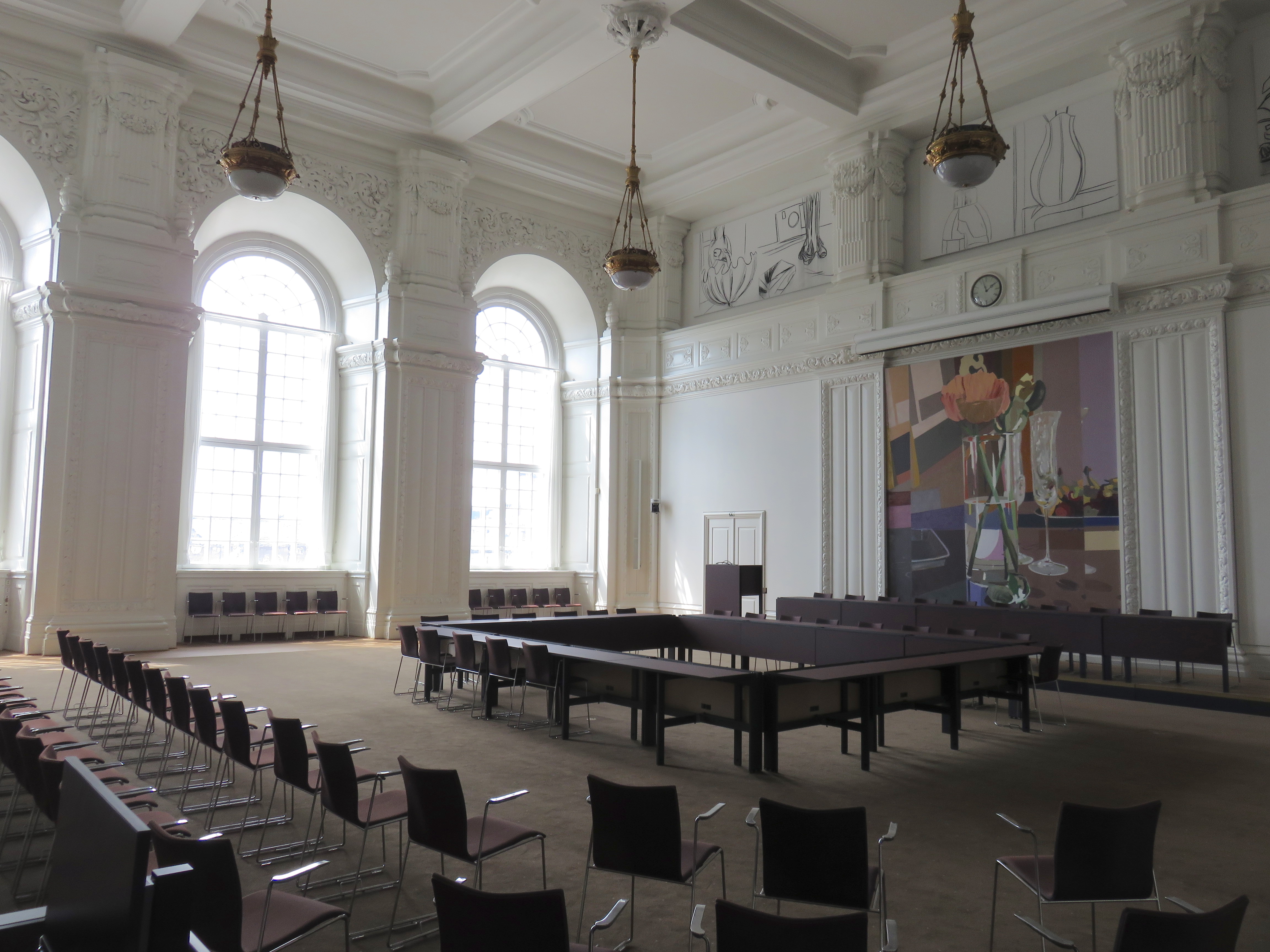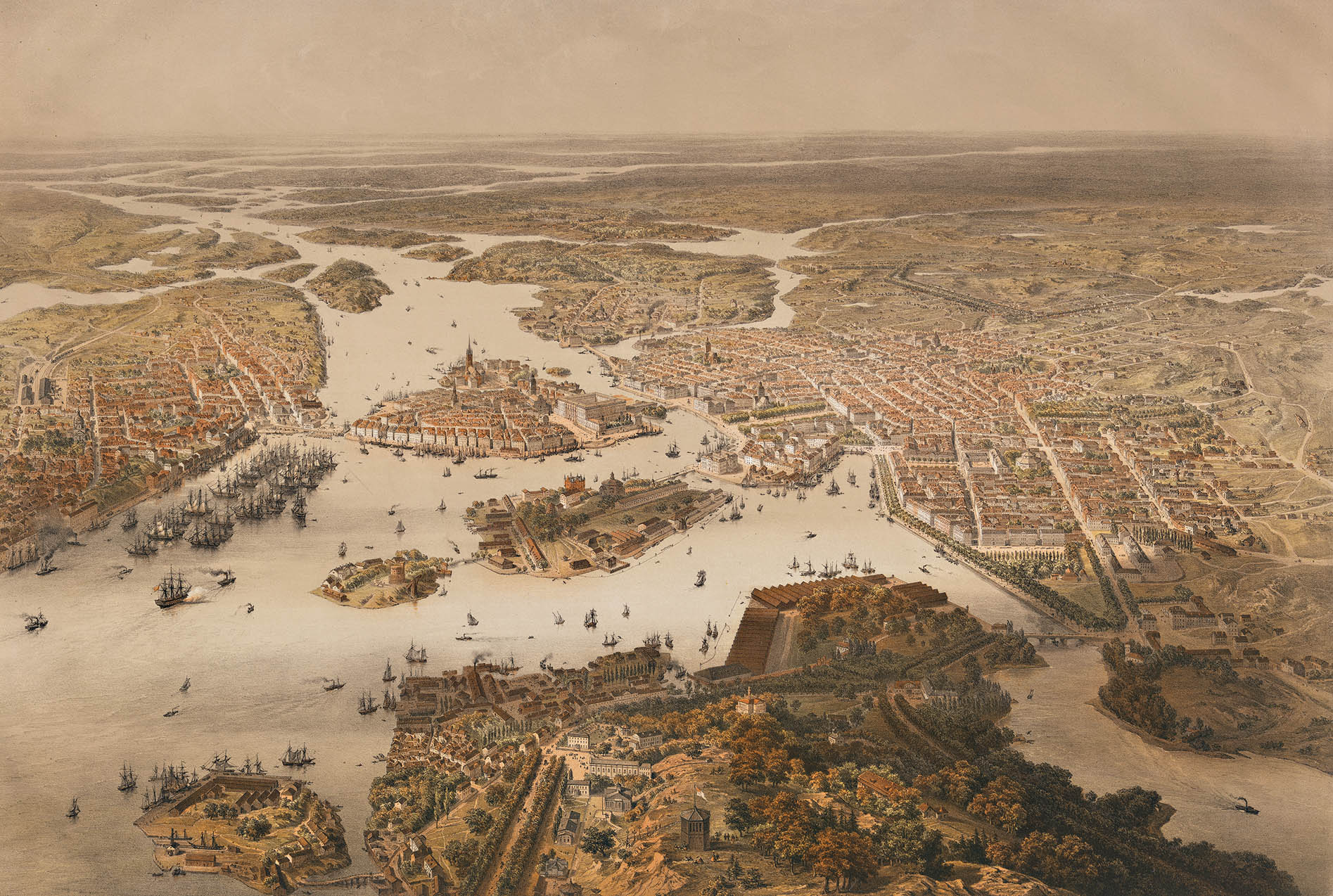|
Stureby
Stureby () is a residential area in southern Stockholm, approx. 3 kilometers from Skanstull. The district at 205 hectares is bordered with Örby, Örby slott, Östberga, Årstafältet, Gamla Enskede, Svedmyra, Gubbängen and Bandhagen. There were farms in the area where Stureby is located in the year 1689 according to a map. The area started to be developed in the year 1921 by the company Fastighets AB Villahem. In 1923 the politicians in Stockholm decided to build a retirement home that was named Gammelbyn to commemorate Gustav Vasa's arrival in Stockholm 400 years earlier. The area was named Stureby after Sten Sture the Younger in 1926. In 1930 the retirement home Gammelbyn was finished and also a new tram station that was part of the tram line Örbybanan. Stureby nursing home opened in 1935. There once lived 1000 people in the retirement home and the nursing home. In 1938 a cinema named Tusse-bio opened in Stureby and was renamed to Corso in 1939. The tram line in Stureby ... [...More Info...] [...Related Items...] OR: [Wikipedia] [Google] [Baidu] |
Svedmyra
Svedmyra is a suburb in Söderort Söderort (literally "the southern place", sometimes translated to ''South Stockholm'') is the southern suburban part of the Stockholm Municipality, Sweden. It is also part of the city of Stockholm. Geography Söderort is located in the nort ... in the municipality of Stockholm Municipality, Stockholm, in the borough of Farsta (borough), Farsta. Svedmyra is located between Stureby and Tallkrogen, and covers about 0.92 km² of land. Svedmyra is surrounded by forests and green space. The population in 2008 was 2,812. The name "Svedmyra" comes from a cottage that was formerly on the site, named ''Svinmyran'', "Pig Bog". The cottage is known since the 14th century, and it belonged to Östberga farm. According to legend, Svedmyra was named after all the red forest ants in the forests around Svedmyra. Boundaries Svedmyra borders Tallkrogen (in Svedmyra Forest and also in Torögatan and then in a line west of Herrhagsvägen), Gubbänge ... [...More Info...] [...Related Items...] OR: [Wikipedia] [Google] [Baidu] |
Svedmyra (tunnelbanestation)
Svedmyra is a suburb in Söderort in the municipality of Stockholm, in the borough of Farsta. Svedmyra is located between Stureby and Tallkrogen, and covers about 0.92 km² of land. Svedmyra is surrounded by forests and green space. The population in 2008 was 2,812. The name "Svedmyra" comes from a cottage that was formerly on the site, named ''Svinmyran'', "Pig Bog". The cottage is known since the 14th century, and it belonged to Östberga farm. According to legend, Svedmyra was named after all the red forest ants in the forests around Svedmyra. Boundaries Svedmyra borders Tallkrogen (in Svedmyra Forest and also in Torögatan and then in a line west of Herrhagsvägen), Gubbängen (at Tallkrogsvägen and further west in Majroskogen towards Örbyleden ), Stureby (north from Örbyleden to Grycksbo road and the metro and along the east side of the metro towards Svedmyraplan) and Gamla Enskede (along Svedmyraplan-Handelsvägen and Svedmyra Forest to a point south of Riskv ... [...More Info...] [...Related Items...] OR: [Wikipedia] [Google] [Baidu] |
Bandhagen
Bandhagen is a suburban district south of Stockholm with 6510 (2018) inhabitants. It is located in the Enskede-Årsta-Vantör borough neighboring Högdalen, Stureby and Örby. The metro station with the same name was opened in 1954. Progressive metal Progressive metal (sometimes shortened to prog metal) is a broad fusion music genre melding heavy metal and progressive rock, combining the loud "aggression" and amplified guitar-driven sound of the former with the more experimental, cerebral ... band, Opeth, formed in Bandhagen in 1989. Sports The following sports clubs are located in Bandhagen: * Rågsveds IF References Districts of Stockholm {{stockholm-geo-stub ... [...More Info...] [...Related Items...] OR: [Wikipedia] [Google] [Baidu] |
Örby
Örby is a residential area in Söderort, Stockholm Municipality, Sweden. It has an area of 159 hectares and 4,720 inhabitants. History Örby got its name from the Örby Manor (''Örby slott''), as does the neighbouring residential area of Örby slott. Örby was created a self-governing village within Brännkyrka Rural District in 1904. The area was amalgamated with Stockholm City in 1913 and the rural district was dissolved. In the present administration of the city, it is part of the borough of Enskede-Årsta-Vantör. Notable buildings Leipzighuset is a multi-dwelling apartment house located at the corner of Turingevägen / Gamla Huddingevägen in Örby. Built in the early 1900s, the architecture differs from other buildings in Örby and was inspired by German metropolitan architecture from the turn of the 1900s. Örbyskolan was built in 1915 and designed by architect Georg A. Nilsson (1871-1949). The building looks like similar schools in Gamla Enskede and Långb ... [...More Info...] [...Related Items...] OR: [Wikipedia] [Google] [Baidu] |
Stockholm Metro
The Stockholm metro ( sv, Stockholms tunnelbana) is a rapid transit system in Stockholm, Sweden. The first line opened in 1950, and today the system has 100 stations in use, of which 47 are underground and 53 above ground. There are three coloured lines, as shown on the tube maps, which form seven numbered routes with different termini. Routes numbered 17, 18 and 19 (green line), 13 and 14 (red line) and 10 and 11 (blue line) all go through the centre of the city, resulting in a very centralized system. All three lines and seven routes interchange at T-Centralen station. Apart from this, there are three other interchange between lines, at Fridhemsplan, Slussen and Gamla stan stations. The metro is equipped with ticket gates. Single tickets may be bought in advance, typically in privately owned smaller shops, on the web, or at ticket machines that are available in all underground stations and on several tram, bus, or boat stops. Tickets are also available at the ticket booth b ... [...More Info...] [...Related Items...] OR: [Wikipedia] [Google] [Baidu] |
Landstinget
Landstinget was the upper house of the Rigsdag (the parliament of Denmark), from 1849 until 1953, when the bicameral system was abolished in favour of unicameralism. Landstinget had powers equal to the Folketing, which made the two houses of parliament hard to distinguish. Originally, membership and the electorate was restricted, and the members were largely conservatives. Membership of the house was then restricted to certain sectors of society: only males with a certain net worth could hold a seat. In 1915, these restrictions were removed, and a few new members were appointed by the existing members. Etymology and earlier use (old Norse: þing) means assembly. It first came into being during Viking times and was formed by the freemen of the community, and it generally numbered about a hundred men. Tings were necessary in the clan-based society of Northern Germany and Scandinavia, because they allowed for inter-clan wars to be resolved or prevented through the mediation of ... [...More Info...] [...Related Items...] OR: [Wikipedia] [Google] [Baidu] |
Sten Sture The Younger
Sten Sture the Younger ( sv, Sten Sture den yngre) (1493 – 3 February 1520), was a Swedish nobleman who served as the regent of Sweden, during the era of the Kalmar Union. Biography Sture was born in 1493, as the son of Svante Nilsson (regent of Sweden) and Iliana Gisladotter Gädda, heiress of Ulvåsa. At the death of his father, regent Svante, Sture was only 18 years old. High Councillor Eric Trolle was chosen as regent by the High Council. He supported the union with Denmark. However, Sture utilized the castles and troops fiefed to him by his late father and executed a coup. After Sture promised to continue union negotiations with Denmark, the High Council accepted him as regent replacing Eric Trolle. In reality, Sture's purpose was to keep Sweden independent from Denmark. He adopted the Sture surname, heritage from his great-grandmother, because it symbolized independence from Denmark and as a reminder of Sten Sture the Elder, his father's third cousin. Conflict so ... [...More Info...] [...Related Items...] OR: [Wikipedia] [Google] [Baidu] |
Gustav Vasa
Gustav I, born Gustav Eriksson of the Vasa noble family and later known as Gustav Vasa (12 May 1496 – 29 September 1560), was King of Sweden from 1523 until his death in 1560, previously self-recognised Protector of the Realm ('' Riksföreståndare'') from 1521, during the ongoing Swedish War of Liberation against King Christian II of Denmark, Norway and Sweden. Gustav rose to lead the rebel movement following the Stockholm Bloodbath, where his father was executed. Gustav's election as king on 6 June 1523 and his triumphant entry into Stockholm eleven days later marked Sweden's final secession from the Kalmar Union. As king, Gustav proved an energetic administrator with a ruthless streak not inferior to his predecessor's, brutally suppressing subsequent uprisings ( three in Dalarna – which had once been the first region to support his claim to the throne – one in Västergötland, and one in Småland). He worked to raise taxes and bring about a Reformation in S ... [...More Info...] [...Related Items...] OR: [Wikipedia] [Google] [Baidu] |
Gubbängen
:''See also Gubbängen metro station for the metro station.'' Gubbängen is a suburban district in the southern part of Stockholm. The metro station was opened in 1950. Gubbängen is located in Farsta which is a borough (''stadsdelsområde'') in Söderort in the southern part of Stockholm Municipality Stockholm Municipality or the City of Stockholm ( sv, Stockholms kommun or ) is a municipality in Stockholm County in east central Sweden. It has the largest population of the 290 municipalities of the country, but one of the smallest areas, maki .... In Gubbängen lies City, a former cinema from the 1950s which currently hosts theatre plays, concerts, art exhibitions, film and occasionally also flea markets. References Districts of Stockholm {{stockholm-geo-stub ... [...More Info...] [...Related Items...] OR: [Wikipedia] [Google] [Baidu] |
Stockholm
Stockholm () is the Capital city, capital and List of urban areas in Sweden by population, most populous city of Sweden as well as the List of urban areas in the Nordic countries, largest urban area in the Nordic countries. Approximately 1 million people live in the Stockholm Municipality, municipality, with 1.6 million in the Stockholm urban area, urban area, and 2.4 million in the Metropolitan Stockholm, metropolitan area. The city stretches across fourteen islands where Mälaren, Lake Mälaren flows into the Baltic Sea. Outside the city to the east, and along the coast, is the island chain of the Stockholm archipelago. The area has been settled since the Stone Age, in the 6th millennium BC, and was founded as a city in 1252 by Swedish statesman Birger Jarl. The city serves as the county seat of Stockholm County. Stockholm is the cultural, media, political, and economic centre of Sweden. The Stockholm region alone accounts for over a third of the country's Gross d ... [...More Info...] [...Related Items...] OR: [Wikipedia] [Google] [Baidu] |







